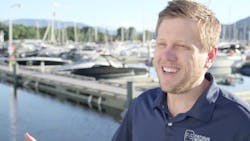For many in the industry, the high-profile crash in New Jersey in 2014 involving a Walmart truck – killing one person and seriously injuring actor/comedian Tracy Morgan – showed the shortcomings of Hours of Service rules. Although the driver was on duty 13-½ hours of his 14-hour workday – still legal - he had been awake more than 28 hours at the time of the crash, according to the National Transportation Safety Board. The trucker commuted 800-miles to his terminal the day before. “Hours of service (HOS) rules cannot address what drivers do on their own time,” said NTSB Chairman Christopher A. Hart.
The NTSB called for fatigue management as an answer to rigid HOS time periods. What's important, NTSB noted, is not how long drivers are on the road, or what they do on their own time, but whether or not they are too tired to drive.
We talked with Sean Kerklaan CEO of Fatigue Science in Vancouver, British Columbia, whose sleep apnea spurred him to find fatigue management solutions for himself and others. We also spoke with Dan DePalma, General Manager – Northern Operations, Kamloops (B.C.) Corporate Operations of Arrow Transportation Systems, Inc., a 350-truck fleet whose drivers are using fatigue-monitoring wearables from Fatigue Science.
Following are edited comments from both of them.
First, Sean Kerklaan.
What got you interested in fatigue management?
I was 21 years old, fairly healthy, fit, not overweight, and it my snoring was killing my relationship. I woke up every morning feeling horrible. It took a year to get into an overnight sleep study called a polysomnography or PSG. When I saw the doctor about six months later he said "You have sleep apnea. Buy this CPAP machine." I tried it for a year but couldn't tolerate it. It took me a long time to see the doctor again and he said, "Get a dental appliance." I could not tolerate that either. I went back to see the doctor and he said, "Actually when we look at your original polysomnography, it shows that 97 percent of your apnea occurred when you were lying on your back. When on your side, you don’t have apnea." I was frustrated as hell that the doctor didn’t tell me that on day-one or even the lab tech the night I left the sleep center. All they had to say was "Go home and sleep on your side." There's no risk in telling somebody to sleep on their side, but instead it took two and a half years and over $5,000.
What did you do next?
I invented a prototype product with some tennis balls and duct tape that prevents you from sleeping on your back. It's an inflatable device, kind of like wearing a bra on your back, that keeps you from sleeping on your back. I will always have sleep apnea, but I don’t suffer from it because I sleep only on my side.
What's the idea behind your company's Readiband wearable product?
You go into a polysomnography, and the doctor tells you that you had four hours of sleep or 82 disruptions. Who cares? How do you actually quantify what that means to you other than it is bad for your health? Our approach is that we can quantify and give you a meaningful understanding of how yesterday's sleep is going to impact your ability to drive safely today.
Let's empower the driver to be self-aware of his condition so instead of drinking three more coffees and two more Red Bulls, he can take a 30 or 45-minute nap at this point in his shift and be safe to drive. If we empower them with that information, I believe that drivers will make much smarter decisions. Today they're flying blind.
Will drivers believe the data that says they're too tired to drive?
My own experience is that I'm never tired. I'm always like, "I can keep going. I can stay up. I can do more things." Then I started wearing our technology and realized that I was able to quantify that I'm as tired as if I had a blood alcohol of 0.08. It changed my whole approach to believing [wrongly] that I'm tough, that I can just have a bit more caffeine, and I can finish this drive. Will all drivers change? Many of them probably will never change, but if they're empowered with the information that if they take a nap at this point instead of at the end of the shift, for instance, many of them will be much safer. I don’t think drivers want to put themselves in danger. They all want to get home to their families.
How does the wearable work?
You strap it on your wrist, and don’t take it off. You wear it and forget it. It's has Bluetooth and syncs seamlessly to your phone. You don’t need to do anything. You don’t need to touch any buttons. It knows where you are, when you sat down to watch Netflix yesterday for an hour, when you read a book and when you slept. Our wearable can track how long you slept and how many sleep disruptions you had throughout the night. The next morning it can measure and model how many quality hours you actually got. After three days of data – we require 72 hours of information– it can tell you how you're going to perform. From the wearer's perspective, they don’t see much data in the first three days. They can see how they're sleeping, but they won't see what's called the SAFTE score. [SAFTE is a biomathematical fatigue model developed by the US Army and validated by the US Department of Transportation.] The wearer can see, for example, that they're at peak performance now and in four and a half hours from now they're going to start diminishing. Their reaction times will slow. The driver can now plan his or her day. It's not punitive. It's not, "You can't work today." It's more about empowering people with information so they can understand how they can be better, do more. If you're sitting at a desk, peak performance probably doesn’t really matter from a safety point of view, but if you're driving a big truck, it does matter.
Talking with Dan DePalma of Arrow.
How many drivers were involved in your fleet's wearables project?
On average we’ve done about 50 drivers a year so we’ve done roughly 200 bands over a four-year period. They were all volunteers.
What were your goals?
We wanted to get some idea of how drivers were with sleep and fatigue and to see what we could learn. The first goal was to educate our workforce, to learn a little bit, make sure they understood a little more about themselves and get some aggregate data that we can share with the fatigue group. We wanted to give them some feedback in terms of the value of [fatigue management] and what it means in terms of reaction time and how effective they are in their job.
What were the drivers' reactions?
They were interested. At the beginning it was brand new and we had to explain what we were doing and what the ultimate goal was. We felt that we were having too many incidents and you always think they’re fatigue-related and we were trying to find any data that would allow us to try to determine if it really was fatigue-related or not. At the beginning there was a little skepticism from drivers but we assured them that it was their information and kept completely confidential within the fatigue group. We made sure that they understood that. We have good relations, a good rapport with our workforce so they trusted us.
What did you learn?
We learned that they didn’t sleep as little as we thought they did. They still could use a little bit more sleep and they could be a little more consistent with their start times when possible because that’s a big part of [not being fatigued.] We also learned that on average ten to twenty percent of our drivers had some sort of sleeping disorder. We took a lot of pride in that because it was a way to give back to our workforce and say, "Look, I think you need some help."
Were you able to see any improvement in accidents or mishaps based on what you got back?
Absolutely. We saw our incident rates drop dramatically. [He did not offer a number.] It's not all attributed to the bands. There are a lot of things that go together when you’re looking at safety. But I believe this was definitely one of them. Making the workforce aware of how fatigue can relate to reaction times is a positive factor. The fact that you and your workforce are aware that fatigue could be an issue means that drivers are less likely to come up with some excuse when they hit a ditch. It made [the issue of fatigue] more transparent. When people know that your awareness is focused on something, they tend to maybe do a little bit better with it.
Where do you go from here?
We’ve got our own onboard technology in our trucks, our own telematics solution. We built it ourselves. We’ve got new customers for it and I’ve always been really keen and so is our fatigue group to see how we can align the two products into one. How can we tie a telematics solution that actually measures and tracks fatigue? Needless to say it’s going to be tricky.
I tell our drivers that we can’t tuck everybody in at night. We can only do our due diligence to make sure that we’re doing all the right things. We educate drivers on how to drive; we educate them on a lot of things over the course of their day. Why not educate them on fatigue? It's an educational tool to help drivers, not to punish them, not to infringe upon their rights. At the end of the day, if you want to help your people and fatigue is a problem, then I think you need to tackle it.
About the Author

Larry Kahaner
Larry Kahaner is an author, journalist, and former FleetOwner contributor.
